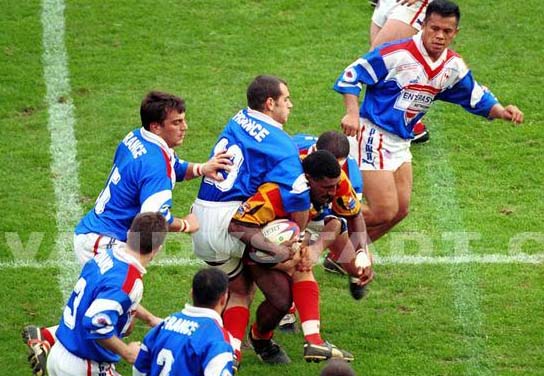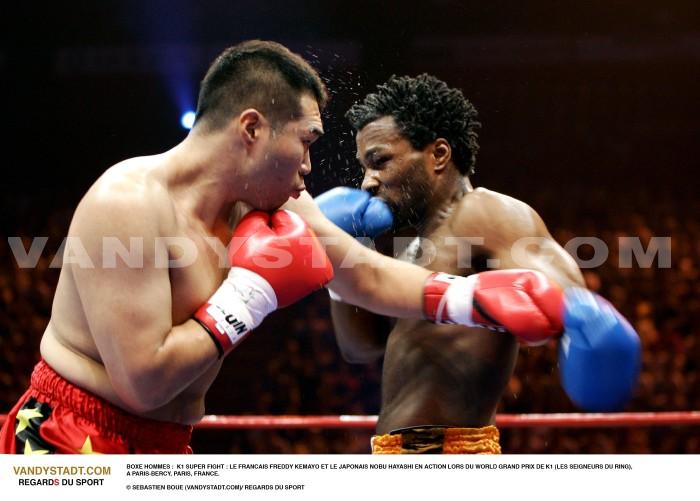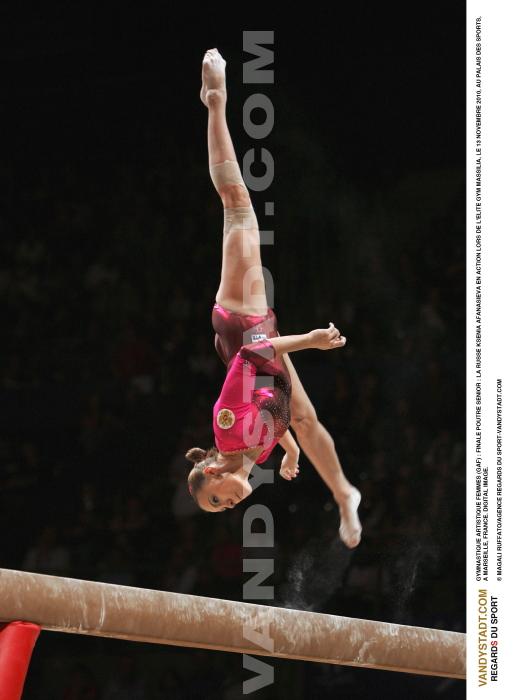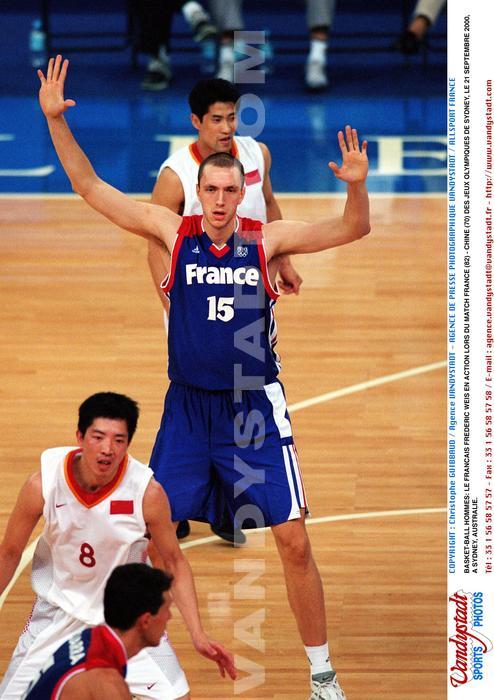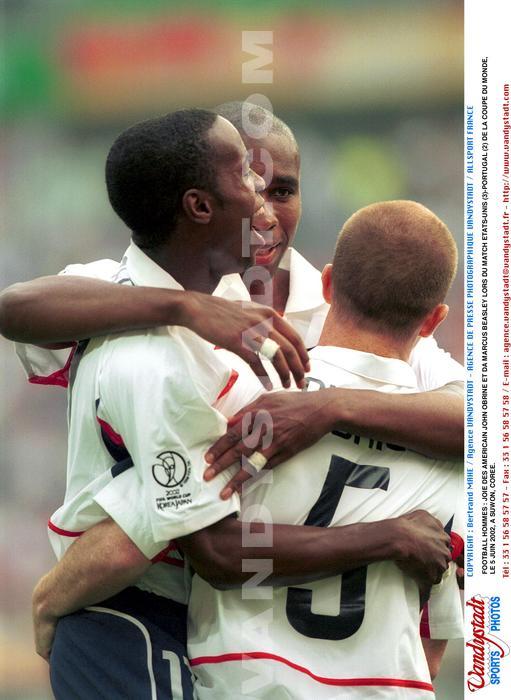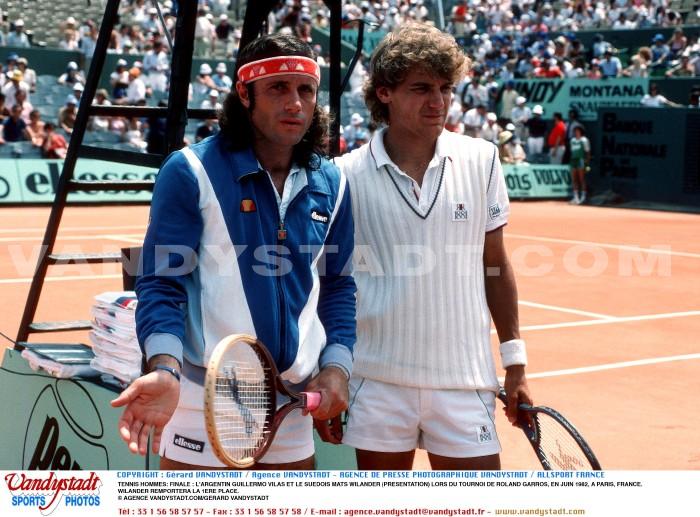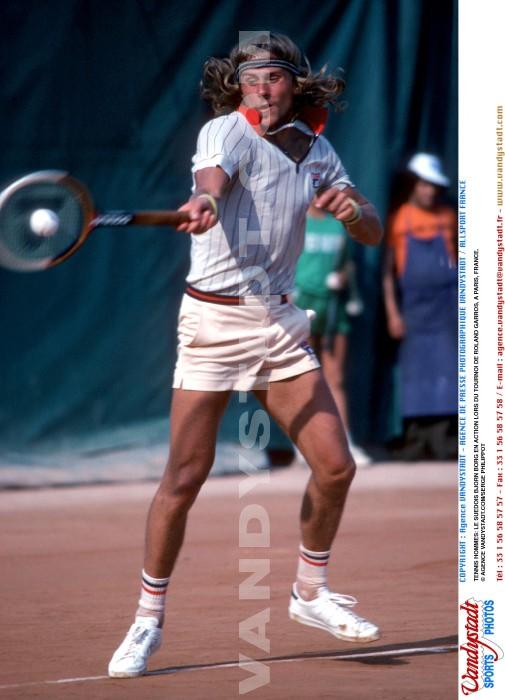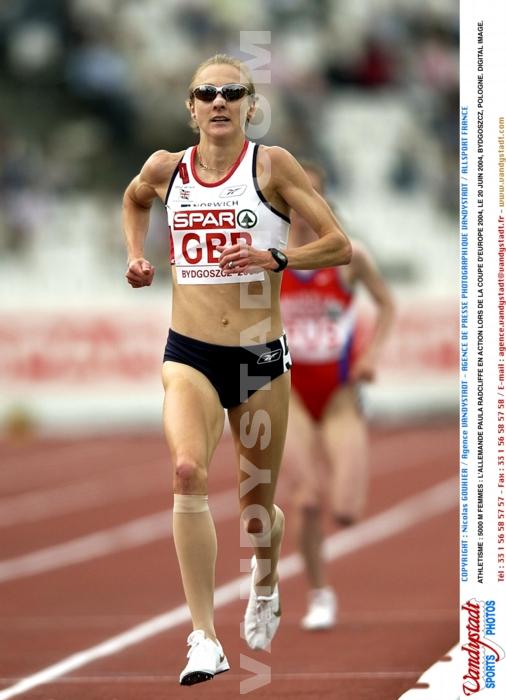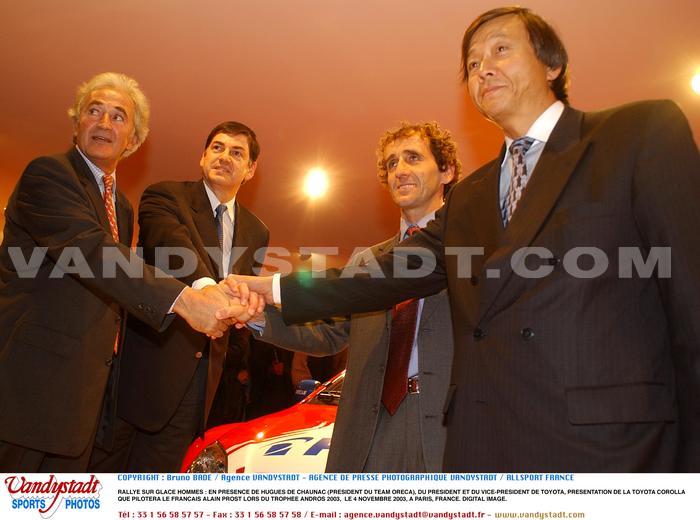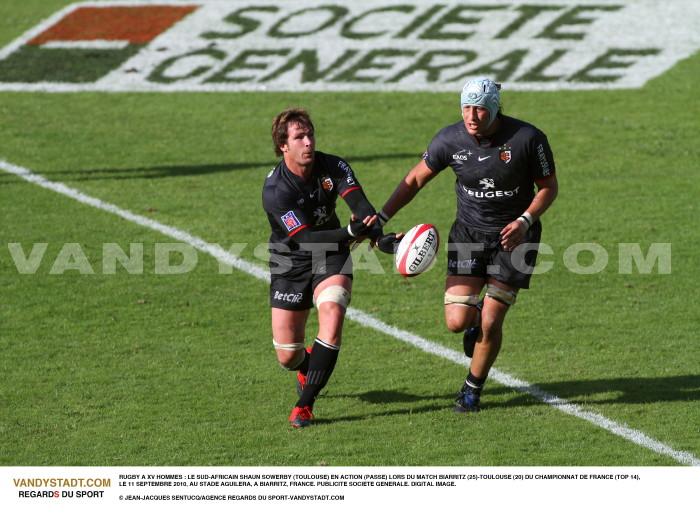Rugby à 13 - Rugby league history
Rugby league
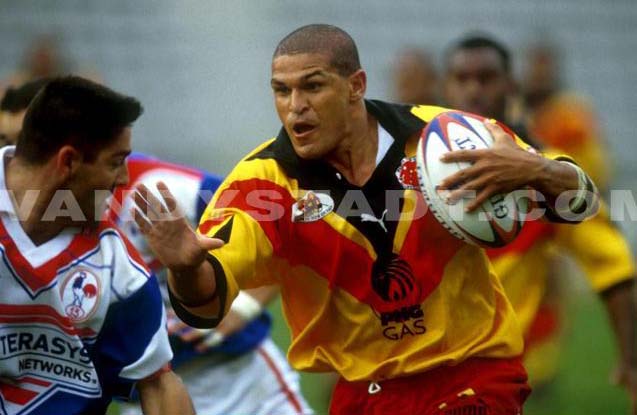
30 100 redundant
- Men: 28 900 - Women: 1 200 to 310 clubs
History
Like most modern sports, rugby was originally developed in England, where the rules have been established. A report of 1897 attributed to William Webb Ellis the innovation of running with the ball. This radical change in football dates from 1823, and went to college in Rugby. After some disputes between the two forms of football, each school develops these subjects within it. The common laws need is felt and January 26, 1871, twenty clubs in the region are meeting in London Charing Cross and founded the Rugby Football Union. On June 24, 1871 a general meeting of the union adopts the "laws of the game," deleting "hackin" (right kicking foot), the hook-in leg, and fixing the number of players at 20. Very soon the university reduce the number of players to 15, which was formalized in 1877 by the Rugby Football Union. The industrial revolution caused a population concentration in cities and the Factory Act of 1847 - leave Saturday afternoon to all - promotes the sport. The North of England is ready to open when sport. The Football Association - soccer - is growing very important, but the matches mobilize the best players from Saturday morning. This shortfall, travel expenses are taken into account by the leading clubs in Yorkshire, although it is not allowed: amateurism Brown has deep roots. The rumors: the Club of Preston - Yorkshire - have offered a player Committee Cumberland money to play with him: The Rugby Union investigation and suspend the offending club: This is the rupture between North and South shortly. In 1891, Yorkshire proposes compensation of players for hours of work lost to rugby practice, the General Assembly rejected this proposal which may tend to that professionalism. This occurs for two brothers James, Welsh international Broughton Rangers, their eviction causes a new General Assembly September 20, 1893 in London. And again by 282 votes against 136, the Assembly rejects the shortfall and reaffirms the "amateurism" of the absolute Rugby Union. The North has experienced another defeat, but he did not admit defeat: 22 clubs met in Leeds in 1895 and this meeting will be born the Northern Rugby Football Union and the recognition of the right to profits. Since the break is consumed, a new sport was born. In 1897, the rules are changed, in 1906 the number of players is reduced from 15 to 13, in 1907 a tour was organized (New Zealanders to discover the Rugby League and introduce the home and in Australia), finally In 1922, the Northern Rugby Football Union is changing its name to the "Rugby Football League. Rugby league, one of three for my existing - rugby and football being the others - is practiced under the auspices of an international federation which defines the rules and organize competitions other than world tour.
The Rugby Football League International Boardtherefore includes the various national federations, each country being represented by his association. Total Licensed: env.300000. Rugby league is played by professional and amateur athletes, they are much more numerous, and each category contains in a league.
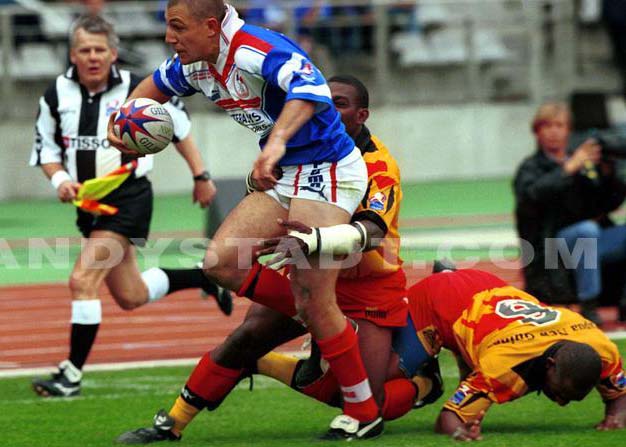
The French Federation of Rugby
In 1872 young practicing English football in a vacant lot Havre based with some native first rugby club in France: Le Havre Athletic Club. Paris soon after and international meetings will take place. On April 6, 1934, the French League rugby league filed its articles to the police headquarters in Paris. On May 17, 1934, six federations opposed to the league and are the federations of rugby, football, athletics, swimming, rowing and tennis but anathema not only hampers the development of thirteen.
On January 12, 1938, after the attacks of Sports Minister of the Popular Front, Léo Lagrange, cons professional sport, the Prime Minister Camille Chautemps given government approval in the French League rugby league. But by the decree of December 19, 1911 League French Rugby League is dissolved.
The game of rugby league hit bottom in 1960: of 5233 graduates in 1951, it is redundant to 3100 in 1966.
The Treiziste general meeting, held January 24, 1988, chose a new name, "Federation of Rugby League", which is consistent with the 1944 Act (requiring federation) and eliminates the risk of confusion due to the addition of 3 generic words. The 1989-1990 season was marked by the historic victory of the France team in Leeds (Great Britain) 25-18.
The State of rugby league, with the creation of a Super League, created by the rivalry between TV channels in Australia will disrupt the established order. The attacks of the mighty Murdoch, instigator of the Super League will waver the powerful Federation of Australia supported by Parker.
Pia XIII is the first time ever Champion of France. The World Cup was held in October 1995 in Britain to celebrate the centenary of rugby league.
The world record for viewers on a rugby stadium league is 104 583, registered at the new Olympic Stadium in Sydney March 6, 1999 for opening the championship of Australia.
A figure of the thirteenth French
- Paul Barriere (1921-2008)
He founded the International Rugby Board and was the father of the first World Cup rugby league organized in 1954 (he refused the trophy that bears his name). President of the French Federation of Rugby League from 1948 to 1955, he is also the source of the first touring team to France in the Southern Hemisphere, in New Zealand in 1951.
Former player of rugby at club Espéraza in Aude, there was a major figure in the Resistance during the Second World War, he also discovered rugby league through actions in the maquis Aude where he forged relationships with officials of the sport, rugby league was banned by the Vichy regime, and likewise it has done everything for his rehabilitation. Between 1990 and 2004, he led the festival of music and theater of the city of Carcassonne.
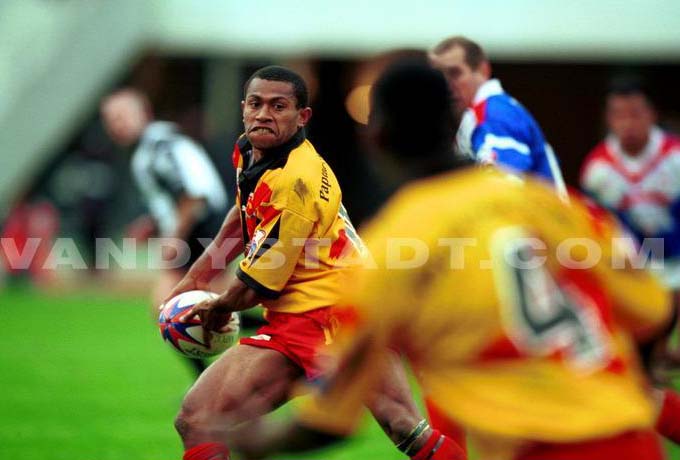
Rules and Principles
Principle
Two teams of thirteen players compete by trying to score the most tries and possible penalties on the opposing team.
Facilities


Equipment
The balloon
1) Form and Matter
The game will be played with an oval ball inflated with air, the outer envelope may be made of leather or other material approved by the Super League World Board. Nothing in the manufacture of the ball shall be a danger to players.
2) Dimensions and weight

The dimensions of the ball are:
- Desired length: 28 cm (minimum: 27 cm, maximum 29 cm);
- Circumference (lengthwise) desired: 74 cm (minimum: 73 cm, maximum 75 cm);
- Circumference (widthwise) desired: 59 cm (minimum: 58 cm, maximum 61 cm);
- Weight (ball clean and dry) desired: 410 g (minimum: 380 g, maximum 440 g).
Balloon deflated
The referee must whistle to stop play as soon as he finds that the shape and dimensions of the ball no longer comply with the rules of the game
Balloon burst
If the balloon bursts when a player attempts on goal after kicking a penalty was awarded, the referee will make another attempt. If a player flattens to score a try and we see that the ball is dead, the trial will be granted.
In any game situation, if the balloon bursts, the game will be stopped, the ball replaced and a scrum formed to begin the game where the ball was dead, the team was in possession or the last team to have been in possession has a "head" and introduction.
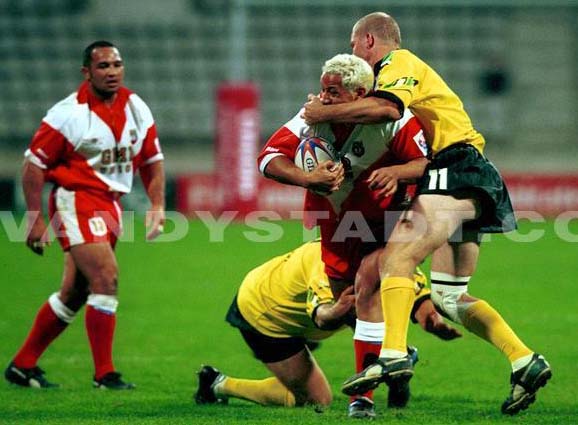
T-shirts
For easier identification of players, it is necessary that their jerseys are numbered (1 to 13 with the following numbers for the replacements):
Backs
No. 1: Background
No. 2: Three-quarters right wing
No. 3: Three-quarters right center
No. 4: Three-quarters left center
No. 5: Three-quarters left wing
No. 6: Opening Half
No. 7: Scrum half
Forwards
No. 8: Pillar later introduction
No. 9: Hooker
No. 10: Pillar opposite side to the introduction
No. 11: Before the second line
No. 12: Before the second line
No. 13: Third line
No. 14: Substitute
No. 15: Substitute
No. 16: Substitute
No 17: Vacancy.
The duration
The normal part is 80 minutes plus stoppages in play
At halftime, there will be a pause of 5 minutes, but the duration of this break may be increased or decreased by the referee.
The main rules
The mark
1) A trial account for 4 points.
- A kick penalty has placed or dropped 2 points.
-A drop kick ( "drop") given during the game counts 1 point.
2) The game will be won by the team that has scored the highest number of points. If both teams have scored an equal number of points or if both teams only managed to score any points, the game will be declared invalid.
Marking field
- The line of 22 meters was replaced by line 20 meters.
- The lines marking the 10 m from the goal lines, 20 m and midfield will be marked dashed across the width of the field.
Attacking player locked in the in-goal
When an attacking player in possession of the ball is locked in the in-goal by opposing one or more defenders and unable to flatten the ball, play is restarted with a scrum 10 meters from the goal line, facing to where the player was immobilized, the attacking team receiving the head and the introduction.
If this occurs after the 5th veneer, a transition has taken place on the line 10 m from the goal line opposite the place where the attacking player has been locked.
Replacements
- The 4 substitute players will sit on the bench.
- The trainer or coach will sign indicating the number of player to replace.
- A single replacement for both team will be tolerated.
- The touch judge will not allow access from the playground to replace, after the exit beyond the limits of that ground game, the player replaced.
- Players can alternately be replaced and then return to the team at will and without waiting for a stoppage in play
- The replacement is carried out at the touch judge, if a substitute player enters the playing area without its consent, the referee penalize a yellow card and the player said leaving will also join the bench The team concerned will be penalized a player for 10 minutes.
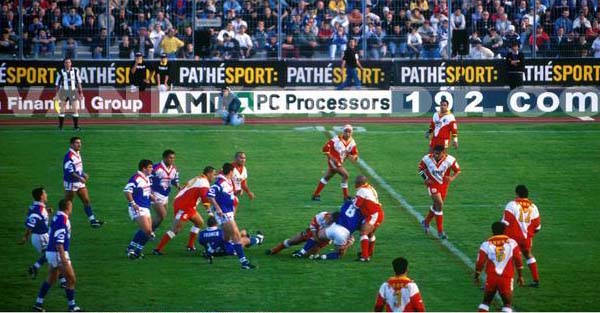
Glossary
Trial. Action "to flatten the ball" inside the in-goal.
Flatten the ball. It is placing the ball on the ground with one hand or both hands, or apply pressure with your hand or arm on the ball already in the ground or dropping the ball already on the ground and cover it with the part body between the neck and waist.
Touch of in-goal. Action by a defending player who crushes the ball into his own in-goal.
Transformation. After a trial marked by a team that has been granted by the referee, a player of this team "turns", adding a shot to "kick placed.
Purpose. Scoring a goal is kicking the ball in one of the ways prescribed, and pass between the goalposts and over the crossbar between them.
Drop. The drop is a goal scored during the game by "drop kick".
Movement of the ball and player positions
Possession. A player fixed or mobile ball carrier is said to "hold".
Behind or ahead. "Behind" means a location farther from the dead ball line opposite this place.
"Behind" means a player standing further from the dead ball line opposing the feet of a player.
"Before a place" means given closer to the dead ball line opposite this place.
"Before a player" means more standing near the dead ball line opposite this place.
"Before a player" means more standing near the dead ball line opposing the feet of a player.
Passe. Gesture of passing the ball between two players.
Forward pass. Action to move the ball towards the dead ball line opponent.
Forward. Allowing escape or throw the ball towards the dead ball line opponent, using their hands or arms. If the ball falls to the ground after being last touched by any other body parts as hands or arms, there is no "forward" and the game can continue properly.
Feint. Gesture is to pretend to pass the ball or thrown away.
Obstruction. Failure to act consisting in any manner whatsoever, on an opponent not carrying the ball. The ball carrier itself can never be guilty of obstruction.
When an offside player (moving out of its own in-goal) occupies a position inconsistent with the rules, it says "offside". A player may be "offside"
- On a throw-in (kickoff or referral drop, light, fight, kick a penalty) in which case his position is assessed by reference to the place where the handing in.
-on a stage play (and he is said to "off-side) in which case his position is assessed by reference to one of his teammates.
Until a player is offside, he is forbidden to deliberately intervene in the game, it is somehow "neutralized".
Being in a position of "offside" is not in itself be penalized, except in the case of kick or drop in for reference.
If the player "offside" voluntarily intervenes, he must be penalized. The player who was "offside" might again intervene in that the improper advantage it enjoyed by virtue of his position has disappeared in the case of players' off-side conditions of his release on - side "are specified.
Involved position player who is not or no longer "outside game" can properly respond.
Free balloon. It said that the ball during the game, is not carried by a player (in possession) or played melee, or played on view.
Ball Unplayable. It said the balloon was released from the playground, is rendered unplayable, the ball can be put into play by one of the ways prescribed.
Against. It intentionally interfere with the hands, arms or other body part on the trajectory of the ball just hit the foot by an opponent (from kick).
The veneer and the light
Plating standing (or blocking). A player standing, carrying the ball, can be considered as veneer, although it has not been brought to ground by the adversary when he must be locked so that it can neither move forward, or pass the ball. They say there are "standing veneer.
Plating wanted. Without a player carrying the ball that gives way to the ground voluntarily or does not rise when he has time and is not plated by opponents.
Held. Action by a player who, after suffering a veneer, puts the ball in play
Transfer ball. It does allow the ball to the opponent after a team has been pressed the number of times prescribed.
Required to transfer. After a number of veneers suffered by any team, the lineout is made by an opponent who plays a light, although he has not himself been plated and is a "light transfer".
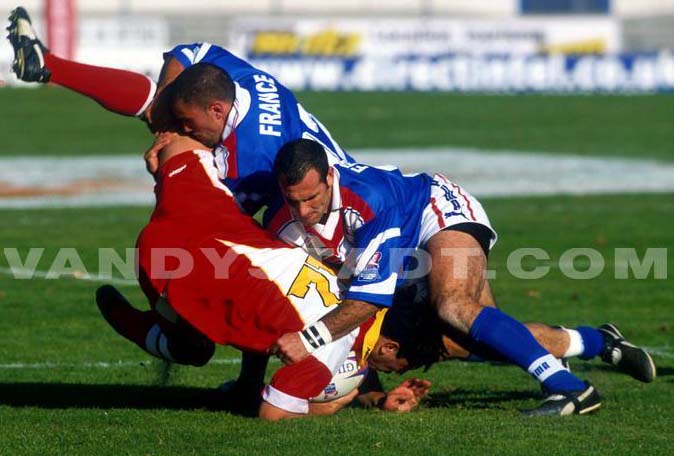
The kicking
Kick. Momentum ball with parts of the leg located between the knee and toe, with the exception of the heel (ie by "kicking").
Placed kick. Kick gave the ball that has been previously placed on the ground therefor.
Drop kick. Kick gave the ball dropped hands or one hand to the ground immediately after its first bounce.
Kick volley. Kick gave the ball, dropped his hands or one hand before it touches the ground.
Kick for himself. Variant of kick volley where the kicker takes the ball after he hit even slightly stolen.
Kickoff. Placed kick gave the middle of the median line and whistled by the referee:
- At the beginning of each half.
- After one or more points just scored a team.
Reference to drop. Throw-in by drop kick is given from the goal line between the goal posts, either from the middle of the line of 22 m.
Front kick. Kick crossing a given line without first bouncing off the playground
Back on direct kick. Lineout ball from a scrum at the start of the kick directly into touch.
Kick penalty. The kick penalty awarded to a team because of the opposing team can play in three ways:
- Either a kick or dropped position to shoot at goal, after informing the referee.
- Or by any prescribed form of kick to put the ball quickly into play
- Or in two stages:
- A shooting touch, with or without prior rebound on the ground, but without contact with another player.
- Followed by a kick (as defined below).
Kick. Kick given to 10 meters in front of the exit of the ball into touch, after the first penalty phase performed in two stages. The kick may be affected in any manner and in any direction, but no points will be scored on this kick. Moreover, if this kick the ball went into touch without first bouncing on the ground, a scrum is ordered at the start of the kick.
The term "tap penalty" previously used to define the kick is excluded.
Tailgate. This gives impetus to the ball, behind the heel or sole of foot.
The scrum
Melee. When a team is denied the benefit of the "head" and the introduction (see below), we say that the scrum is awarded "cons" that team.
Introduction. Gesture of putting the ball in the middle of the melee, while driving on the ground.
Having the head. Made for a pillar melee to be closest to the arbitrator (the side where the ball will be introduced);
The pillar which "head" is specially called in English the "prop".
Copyright Sportquick/Promedi








